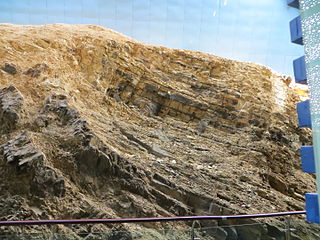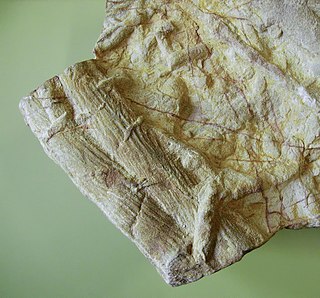The Cambrian Period was the first geological period of the Paleozoic Era, and of the Phanerozoic Eon. The Cambrian lasted 55.6 million years from the end of the preceding Ediacaran Period 541 million years ago (mya) to the beginning of the Ordovician Period 485.4 mya. Its subdivisions, and its base, are somewhat in flux. The period was established as "Cambrian series" by Adam Sedgwick, who named it after Cambria, the Latin name for 'Cymru' (Wales), where Britain's Cambrian rocks are best exposed. The Cambrian is unique in its unusually high proportion of lagerstätte sedimentary deposits, sites of exceptional preservation where "soft" parts of organisms are preserved as well as their more resistant shells. As a result, our understanding of the Cambrian biology surpasses that of some later periods.

A fossil is any preserved remains, impression, or trace of any once-living thing from a past geological age. Examples include bones, shells, exoskeletons, stone imprints of animals or microbes, objects preserved in amber, hair, petrified wood, oil, coal, and DNA remnants. The totality of fossils is known as the fossil record.

Paleontology, also spelled palaeontology or palæontology, is the scientific study of life that existed prior to, and sometimes including, the start of the Holocene Epoch. It includes the study of fossils to classify organisms and study interactions with each other and their environments. Paleontological observations have been documented as far back as the 5th century BCE. The science became established in the 18th century as a result of Georges Cuvier's work on comparative anatomy, and developed rapidly in the 19th century. The term itself originates from Greek παλαιός, palaios, "old, ancient", ὄν, on, "being, creature", and λόγος, logos, "speech, thought, study".

The Maotianshan Shales are a series of Early Cambrian deposits in the Chiungchussu Formation, famous for their Konservat Lagerstätten, deposits known for the exceptional preservation of fossilized organisms or traces. The Maotianshan Shales form one of some forty Cambrian fossil locations worldwide exhibiting exquisite preservation of rarely preserved, non-mineralized soft tissue, comparable to the fossils of the Burgess Shale. They take their name from Maotianshan Hill in Chengjiang County, Yunnan Province, China.

Dickinsonia is an extinct genus of basal animal that lived during the late Ediacaran period in what is now Australia, China, India, Russia and Ukraine. The individual Dickinsonia typically resembles a bilaterally symmetrical ribbed oval. Its affinities are presently unknown; its mode of growth is consistent with a stem-group bilaterian affinity, though some have suggested that it belongs to the fungi, or even an "extinct kingdom". The discovery of cholesterol molecules in fossils of Dickinsonia lends support to the idea that Dickinsonia was an animal.

A trace fossil, also ichnofossil, is a fossil record of biological activity but not the preserved remains of the plant or animal itself. Trace fossils contrast with body fossils, which are the fossilized remains of parts of organisms' bodies, usually altered by later chemical activity or mineralization. Ichnology is the study of such trace fossils and is the work of ichnologists.

Kimberella is an extinct genus of bilaterian known only from rocks of the Ediacaran period. The slug-like organism fed by scratching the microbial surface on which it dwelt in a manner similar to the gastropods, although its affinity with this group is contentious.

The Ediacaranbiota is a taxonomic period classification that consists of all life forms that were present on Earth during the Ediacaran Period. These were composed of enigmatic tubular and frond-shaped, mostly sessile, organisms. Trace fossils of these organisms have been found worldwide, and represent the earliest known complex multicellular organisms.

Cruziana is a trace fossil consisting of elongate, bilobed, approximately bilaterally symmetrical burrows, usually preserved along bedding planes, with a sculpture of repeated striations that are mostly oblique to the long dimension. It is found in marine and freshwater sediments. It first appears in upper Fortunian rocks of northern Iran and northern Norway. Cruziana has been extensively studied because it has uses in biostratigraphy, and because the traces can reveal many aspects of their makers' behavior.

The "Cambrian substrate revolution" or "Agronomic revolution", evidenced in trace fossils, is the diversification of animal burrowing during the early Cambrian period.

Helcionellid or Helcionelliformes is an order of small fossil shells that are universally interpreted as molluscs, though no sources spell out why this taxonomic interpretation is preferred. These animals are first found about 540 to 530 million years ago in the late Nemakit-Daldynian age, which is the earliest part of the Cambrian period. A single species persisted to the Early Ordovician. These fossils are component of the small shelly fossils (SSF) assemblages.

Palaeopascichnus is an Ediacaran fossil comprising a series of lobes, first originating before the Gaskiers glaciation; it is plausibly a protozoan, but probably unrelated to the classical 'Ediacaran biota'. Once thought to represent a trace fossil, it is now recognized as a body fossil and corresponds to the skeleton of an agglutinating organism.
The Cambrian explosion or Cambrian radiation was an event approximately 541 million years ago in the Cambrian period when practically all major animal phyla started appearing in the fossil record. It lasted for about 13 – 25 million years and resulted in the divergence of most modern metazoan phyla. The event was accompanied by major diversifications in other groups of organisms as well.
Yelovichnus is an "enigmatic" genus known from fossils of the Ediacaran period. Yelovichnus was originally believed to be an ichnotaxon: its fossils, because of their "meandering nature", were initially thought to be feeding trails left by other life forms, such as annelids or mollusks. Better-preserved specimens later demonstrated that the fossils were not true feeding trails, as there was no evidence of turning by the life form that supposedly left them. The fossils are now recognized as belonging to an organism taking the form of "collapsed, segmented tubes", possibly an alga or a protist. It has also been argued that Yelovichnus and similar organisms are xenophyophores, large but single-cellular organisms that exist today in the abyssal zone. Due to similar structures found in their fossils, it is theorized that Yelovichnus may be related to Palaeopascichnus, as well as Aspidella and Neonereites. The main difference between Yelovichnus and Palaeopasicichnus is the shape of their segments: the segments of Yelovichnus took the shape of "closed, ovate-shaped loops", whereas the segments of Palaeopascichnus were quite varied in shape.

Gregory John Retallack is an Australian paleontologist, geologist, and author who specializes in the study of fossil soils (paleopedology). His research has examined the fossil record of soils though major events in Earth history, extending back some 4.6 billion years. Among his publications he has written two standard paleopedology textbooks, said N. Jones in Nature Geoscience "Retallack has literally written the book on ancient soils."

Spreite, meaning leaf-blade in German is a stacked, curved, layered structure that is characteristic of certain trace fossils. They are formed by invertebrate organisms tunneling back and forth through sediment in search of food. The organism moves perpendicularly just enough at the start of each back-and-forth pass so that it avoids reworking a previously tunneled area, thereby ensuring that it only makes feeding passes through fresh, unworked sediment.

Muensteria is the ichnogenus of a type of trace fossil that is found in sedimentary rocks, and is thought to represent the horizontal burrow of a marine invertebrate organism. It is a horizontal, non-branching, unlined, tube-like burrow characterized by menisci, which are concave to flat laminae within the burrow created as the organism packs sediment and fecal material behind it when moving forward in the burrow. Muensteria is one example of a meniscate burrow.

Ranquil Formation is a Miocene and Pliocene sedimentary formation located in Arauco Province in south–central Chile, including outcrops in Mocha Island. The formation has its greatest thicknesses in the south-west, where its sediments were largely deposited in marine conditions. It overlies unconformably sedimentary formations of the Paleocene-Eocene Lebu Group. The formation is part of the fill of Arauco Basin which is a sedimentary basin that extends south of Concepción.
Orbisiana is an Ediacaran benthic organism formed of series of agglutinated spherical or hemispherical chambers. It is believed to be a close relative of Palaeopascichnus.












